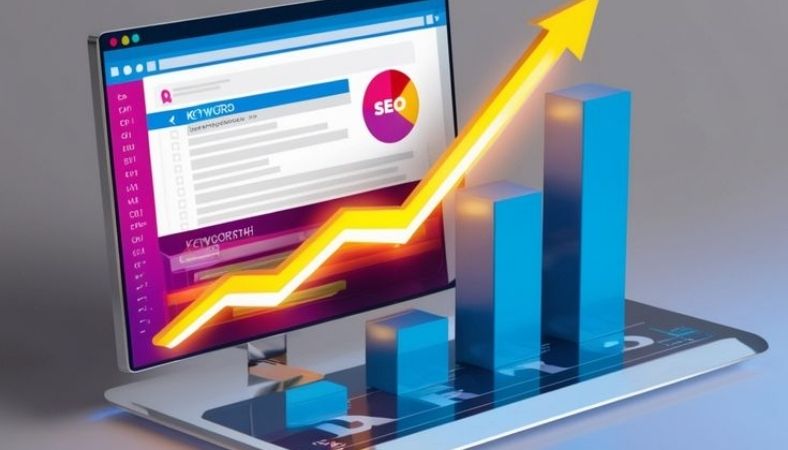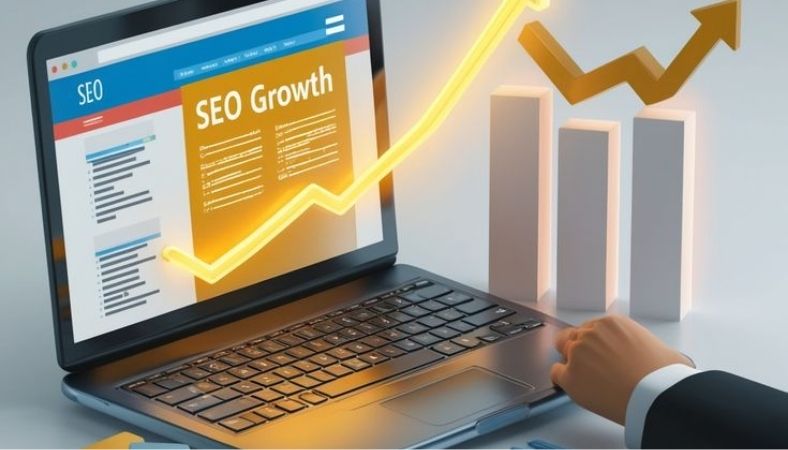In the modern age, slow website loading poses a significant issue, especially for first-time visitors. You run the risk of losing new site visitors, potential clients, and ultimately, revenue. This boils down to the fact that site speed is critical for SEO ranking. Google considers page speed as one of the critical benchmarks of importance when ranking pages, especially with the mobile-first indexing approach that most search engines use.
In this article, I will detail the reasons why site speed is important for SEO and share actionable tips to improve website performance. You will grasp the effects of site speed improvements on SEO strategy, and the various factors that need to be optimised to improve the site’s loading speed.
Site Speed SEO might sound confusing but, simply put, it is the practice of improving the loading time for your website in order to improve user experience and your standing in search engines. Google guarantees that page ranking can only improve if the site loads within a fraction of a second. It is easier to outperform other websites in the SERPs if your site loads faster. Though, it does affect the bounce rate and user engagement time, thus having an impact on a website’s conversion optimisation.
Why You Should Pay Attention To Site Speed SEO?
- User Experience (UX): You’ve probably noticed that webpages which load quicker tend to increase user engagement and you would be right!
- Search Engine Ranking: Especially when it comes to mobile searches, Google regards page speed as one of the most important ranking criteria.
- Conversion Rate: Any increase in the time it takes for users to access a given webpage will lead to a decline in conversion rate. Conversion rate is the measure used to gauge an organisation’s sales along with possible sales leads.
- Bounce Rate: These webpages which take a long time to load tend to exhibit high bounce rates. This means that the site has very little regard for the user experience.

How SEO is Affected by Site Speed: The Key Connection
Both Google and other search engines highly favour websites that maintain a positive user experience. A website that is slower than usual can be punished through negative rankings, opposed to faster sites which seem to always be rewarded. Websites that take longer than one second to load will economically hurt the business in the long run.
Primary Elements of a Site’s Performance:
- Google’s Core Web Vitals: These include the page’s loading speed of the largest part of the content on the web page which is the Largest Contentful Paint (LCP), First Input Delay (FID) and Cumulative Layout Shift (CLS).
- Mobile Friendly Approach: There is rapid growth in the number of users searching for information on mobile devices. So now the mobile first indexing is becoming standard which makes speed even more critical.
- User Engagement: Interactive tasks online are easier to complete when the sites load in a short time. Thus, a lower load time will engage users to use the website as much as possible.
Gaining Insights into Core Web Vitals and Their Importance
Core Web Vitals by Google evaluates a website’s user experience related to the speed of the system, responsiveness, and other factors. Concentrating on visual consistency and responsiveness, these metrics influence the overall search ranking health of the website.
Kerning Web Vitals Metrics:
- LCP (Largest Contentful Paint): This metric focuses on the loading time of the webpage’s largest component or asset.
- First Input Delay (FID): This metric defines how fast a webpage takes to respond after a user performs their first action.
- Cumulative Layout Shift: This metric helps capture the historical shift of content/page x and the overall motion homogeneity concerning the stability of the page as it loads.
Why Core Web Vitals Matters:
- Enhancing User Experience: E-commerce businesses and services that perform well on these metrics improve users’ experience performance.
- Effect on Rankings: It certainly will lower scores and cause ranking decrease.
- Insights that can be acted on: By mastering these verticals, your site will improve precision in user engagement and will enhance speed and stability performance while refining accuracy responsiveness.
Measuring site speed: Tools available
Benchmarking before you commence working on speed optimisation is extremely important. There are many platforms that assess your performance metrics and provide invaluable feedback regarding the identified gaps.
Tools Available for Checking Site Speed:
- Google Pagespeed Insights: Provides automated evaluations and suggestions for improvements alongside detailed reports.
- GTmetrix: Offers in-depth load time analysis, as well as page size and speed improvement recommendations.
- Pingdom: Allows you to test your website speed from different locations around the globe.
- WebPageTest: Offers comprehensive performance breakdowns, including time to first byte (TTFB) and various metrics for visual performance.
How These Tools Are Useful:
- Spot the Problem: Find problem areas on your website, including images that are too large, heavy Javascript, and slow server response time.
- Help Mobile Responsiveness: Many of these tools measure the speed at which mobile pages load, which is crucial because of Google’s mobile-first indexing.
Help Optimise Overall Site Speed: Actionable Strategies
Website speed encompasses a variety of areas, such as image optimisation and reducing server load. Here are the most effective strategies:
Key strategies to improve site load speeds include:
- Image Optimisation: Always edit images to an appropriate size for the context in which they will be used. Use modern file formats such as WebP for better loading times.
- Browser Caching: Permit static resources to be saved locally. This allows users to retain access to resources without having to download them on every visit.
- Content Delivery Network (CDN): A CDN copies your content to servers all around the globe. This means that users, no matter how far from your physical location, can quickly access your content.
- Reduce Your Website’s Server Response Time: Choose a reliable hosting provider and ensure that your server is sufficiently provisioned to handle spikes in traffic.
Choosing The Best Web Hosting Service To Boost Speed Enhancements
Website speed is crucial as your site grows. An Internet Hosting Provider (IHP) can greatly influence your website’s speed. For example, if you take up their shared hosting plan, you may experience significant downtimes during peak traffic periods, because of the cheap services they offer.
Website Performance Improvement Ideas:
- Dedicated Hosting: In this scenario, your website has a complete server dedicated solely to it. As such, consistent high traffic and heavy traffic periods will not impact load times.
- VPS hosting: You’ll receive more resources than what a shared server offers. While still more affordable than dedicated servers, a VPS offers superior response times and uptime.
- Cloud Hosting: Adapts to demand during peak hours with increased resources and reduces servicing during low traffic hours. Provides even more value during high demand periods.
Why It’s Important To Address Speed Guidelines For Mobile Sites
Mobile sites are a priority for Google. Thus, poor performance optimisation increases bounce rates as users lose interest. Businesses should anticipate that mobile visitors want a welcoming interface coupled with speedy performance. If these criteria are not satisfied, companies risk losing significant business traffic.
Mobile optimisation help:
- Responsive design: Make your websites responsive to ensure they can adapt to any screen size.
- AMP (Accelerated Mobile Pages): AMP helps remove unnecessary details from the page that can slow down mobile access significantly.
- Mobile-Friendly Testing: Check and maintain the performance efficiency periodically for mobile to maintain quick load times.
- Case Study: What Impact Site Speed Improvements Affected Ranking
A case study goes a long way in proving the relevance site speed has. We’ll discuss, for example, an online shopping store which improved their site speed by 50%, reducing their page load time from 4 seconds to 2 seconds.
Results:
- Enhanced Organic Traffic: Traffic increased by 25% due to improved site load time.
- Increased Conversion Rates: An improved overall experience increased conversion rates by 15%.
- Improved Site Ranking: The website improved its ranking for mobile and overall searches.
Site Speed’s Importance in Conversion Optimisation
Now, speed is just as important as SEO and conversions. It’s even more critical for online retail businesses where users will abandon a site faster than you can imagine if it’s slow. Having faster sites not only benefits users’ experiences but also helps increase the chances that users will convert.
A few ideas that can help with Conversion Rate Optimisation.
Get rid of targeted pop-up advertisements.
Pop-ups irritate visitors, causing them to leave the site permanently, which increases the bounce rate. Also, both types of ad pop-ups will only serve to make the site slower.
- Streamlined Checkout Process: Quick access to your checkout page increases the likelihood that customers will not abandon their carts.
- A/B Testing: With A/B testing different website versions, you can find a layout that is the best with the lowest load times and highest conversion rate.
Evaluation: Site Traffic
Optimisation efforts must be monitored for improvement results. Changes made within the timeframe must be benchmarked, therefore the same methods utilised prior to site modifications need to be used post-changes.
Key Changes to Analyse:
- Website Load Time: As with any optimisations, ensure to measure the time taken for the website to fully load for any timeframe improvements post changes to verify enhancement.
- Bounce Rate: Check whether there is an improvement in the bounce rate with the improvement of page load times.
- Conversion Rates: Analyse the increase in conversion rates because of the improvement in conversion user experience with better site speed.
Frequently Asked Questions
How can I check my website’s speed?
Google, Bing, GTMetrix and Pingdom offer great page speed test tools that can assess the speed of your website and offer valuable insights for improvement.
What is an optimal page load time for SEO purposes?
As it enhances user experience and increases Google rankings, having a page load time between 2-3 seconds would be ideal.
How can I increase mobile site speed?
Implement responsive designs, Accelerated Mobile Pages (AMP ) and image compression strategies specifically targeted to mobile content to increase speed.
Does website speed impact SEO rankings?
Absolutely. Slow sites tend to receive lower rankings on mobile searches because Google penalises those which take too long.
What is the ideal hosting provider for site speed?
VPS dedicated or cloud hosting often outperforms shared hosting during periods of peak traffic, making them the better option for site speed.
Conclusion
Optimizing site speed is one of the keys to reaching SEO targets today. User engagement and conversion rates will increase, too. By applying these techniques you can see improved site performance, better rankings, and provide users with an enhanced experience.
At the core, website speed optimization should always be your top priority. Focus on regularly monitoring performance levels, making necessary modifications, and adapting to Google algorithm updates in order to stay ahead of competitors in search rankings competition.

